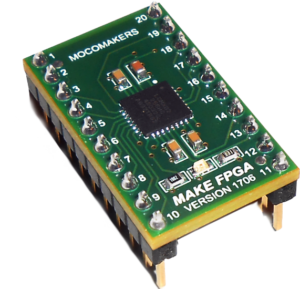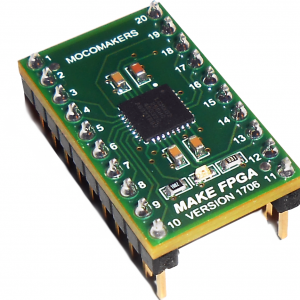FIPSY FPGA BREAKOUT BOARD
A COMMUNITY DEVELOPED PRODUCT.
Supported by dozens of examples.

Our Kickstarter was a Success!!
Thank you to those who helped launch our Kickstarter into production!
Purchase your Fipsy FPGA
Fipsy FPGA Breakout Board
- 256 LUTs
- Operating Supply Voltage: 3.3 V
- Distributed RAM: 2 kbit
- Number of Logic Array Blocks – LABs: 32
- Maximum Operating Frequency: 269 MHz
- FPGA Chip: LCMXO2-256HC-4SG32C
- Ultra Low Power Devices
- Non-Volatile, Infinitely Reconfigurable
- Programmable by SPI and I2C
- Based on the MachXO2 Family of FPGAs from Lattice Semiconductors
- Onboard LED allows for simple testing
- High Performance, Flexible I/O Buffer supports a wide range of interfaces including:
- LVCMOS 3.3/2.5/1.8/1.5/1.2
- LVTTL
- LVDS
- Bus-LVDS
- MLVDS
- RSDS
- LVPECL
- SSTL 25/18
- HSTL 18
- Schmitt trigger inputs, up to 0.5 V hysteresis
Manufactured by –
Set-up software, and instructions can be found here: Basic Setup
Schematic: ACW17003_FIPSY_X2_SCH
Datasheet for the FPGA – MachX02 Datasheet
Chip Applications
- Learn about FGPA design
- I/O Port extender
- Glue between different embedded systems
- Software-based circuit configuration
- Simplified prototype boards, e.g. to wire up microcontrollers and periphery electronics on the fly
- Digital bus controller
- PWM controller, e.g. for huge LED panels
- Frequency generation
- Realtime modification of signal streams, such as HDMI
- Create neural network analogues
Why an FPGA?
FPGAs, or Field Programmable Gate Arrays allow a designer to rewire logic circuits at that hardware level, on the fly. This can greatly speed up processing or allow for massively parallel operations. FPGAs are described as a system designers ‘magical black bag’, in that they can be dynamically reconfigured to match any system. However, FPGAs are a mysterious topic to most DIY tech-types. Specifically, the barriers to entry are the large learning curves, high costs, and limited open source examples.
We are building exactly the board we wished we had when we were learning about FPGAs. The Kickstarter will launch a supply of DIY-friendly FPGA boards. Funding will be reinvested in purchasing additional boards so that cheap FPGAs will be available to all future makers. MoCo Makers supports the learning process with step-by-step guides published on Instructables, Hackaday.io, our blog, and other places across the internet.
Advantages
- A very low price point for an introductory FPGA board. Other boards are closer to $60, which is too much of a price barrier for non-engineer/hobbyist. We are closer to $12.
- Designed for rapid prototyping – with a breadboard-compatible design
- Only uses free or open source design tools
- Supported by numerous examples and guides from a DIY community
- FPGAs fundamentally allow for ongoing, and adaptable hardware configurations and control, even once embedded
- Does not lose state on reboot
Who we are
Started in June 2016, MoCo Makers is a rapidly growing community of over 1200 Makers. We promote self-development and hands-on creation of ideas, prototypes, and physical creations. We host regular free events on topics ranging from introductory electronics, to machine learning, to commercializing prototypes, and more. While open to all skill levels, we have a solid core of technology experts that are pushing the boundaries of tech entrepreneurship.
All our projects are collaborations among our community members. We bring skilled engineers, serial entrepreneurs, developers, and designers into every product we produce. We are proud to help hobbyists scale up big ideas.


